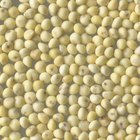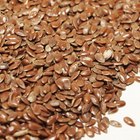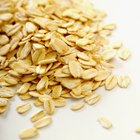Mizina/iStock/GettyImages
Flaxseed comes from the same plant that supplies linen for weaving, linseed oil for artists' paints and natural linoleum flooring. This versatile plant's seeds have a mild nutty flavor that your family will enjoy; they also contain a rich supply of nutrients. Use of flaxseed in cooking depends on the fineness of its grind. Flour made from the seed melts away, while coarser meal holds its shape in a dish.
Benefits of Flax
Flaxseed has a firm, shiny outer coating that varies from a golden wheat hue to a deep toasty brown. Both colors have the same nutritional profile, but you might opt for the golden variety in light-hued foods and use the darker kind in more vividly colored dishes. Golden flaxseed has a milder flavor, as well. As meal or as flour, nutritionally dense flaxseed contains 1 gram of protein and 2 grams of fiber per tablespoon. They're also one of the few plant-based sources of omega-3 fatty acids, so they'll suit older children who are exploring vegetarian eating and younger children who turn their noses up at oily fish such as salmon and tuna.
Flaxseed Meal
Flaxseeds taste a little like the sesame seeds they resemble, but a little strong and almost fishy. To get more of that nutty flavor, grind or mash the seeds. Grinding the seeds into flaxseed meal makes them more easily digestible for children and lets you add them to more kid-friendly forms such as hot breakfast cereal or pancake batter. Add a tablespoon or two of these high-fiber seeds in meal form to any dish that could use a little crunch and taste. Sprinkle coarsely-ground flaxseed meal on yogurt or mix it into a meatloaf to add fiber along with a packet of seasoning mix for extra taste.
Flaxseed Flour
Flaxseed flour differs from flaxseed meal in its texture. The particles of flax in the flour are so small that you can't readily see them without a magnifying glass. Although it looks like whole-wheat flour, finely-milled flaxseed flour lacks wheat flour's gluten, so it won't make a fluffy bread by itself. It's low in starch, so it won't thicken a sauce in the same way, either. However, adding a little of this nutritious flour in place of a portion of wheat flour will add fiber and protein to the finished product. You may have to add more water to a recipe containing flaxseed flour to account for the high fiber content of the seeds; flaxseed flour soaks up moisture quickly.
When to Use Flour, When to Use Meal
Like most flours, flaxseed flour becomes a paste when you add water to it. This texture works if you want to add flaxseed invisibly to creamy dishes like a risotto or use the flour to replace part of a grain-based flour in baking. You wouldn't want to sprinkle it on ice cream or mix it into your family's breakfast cereal, though. Flaxseed meal lends itself to dishes in which it occupies a more prominent place such as in salads with creamy dressing or on breaded cutlets.
Related Articles

Is Teff Flour Gluten-Free?
Can I Grind Quinoa?

Turmeric & Besan for Hair Removal?
How to Substitute Chia for Xanthan Gum

How to Use Panko
Baking With Almond, Rice & Coconut Flour

Nutrition Value of Corn Meal

The Nutrition in Coconut Powder

The History of Butternut Squash

How to Cook With Coconut Flour for Main ...
Substitutes for Oat Bran

How to Cook Millet Meal
Old Fashioned Oats in Place of ...

How to Bake With Flax Seed
Can You Eat Bulgur Like Oatmeal?

Purpose of Rolled Oats in Baking

Uses of Tamarind Seeds

How Do Different Types of Flour Affect ...

Can You Use Konjac Flour in Baking?

Psyllium Husk & Gluten
References
Writer Bio
Lauren Whitney covers science, health, fitness, fashion, food and weight loss. She has been writing professionally since 2009 and teaches hatha yoga in a home studio. Whitney holds bachelor's degrees in English and biology from the University of New Orleans.